How AI Agents are Transforming HR Operations
Transform HR operations with AI agents to automate tasks, enhance onboarding, and revolutionize talent acquisition. Explore solutions today!
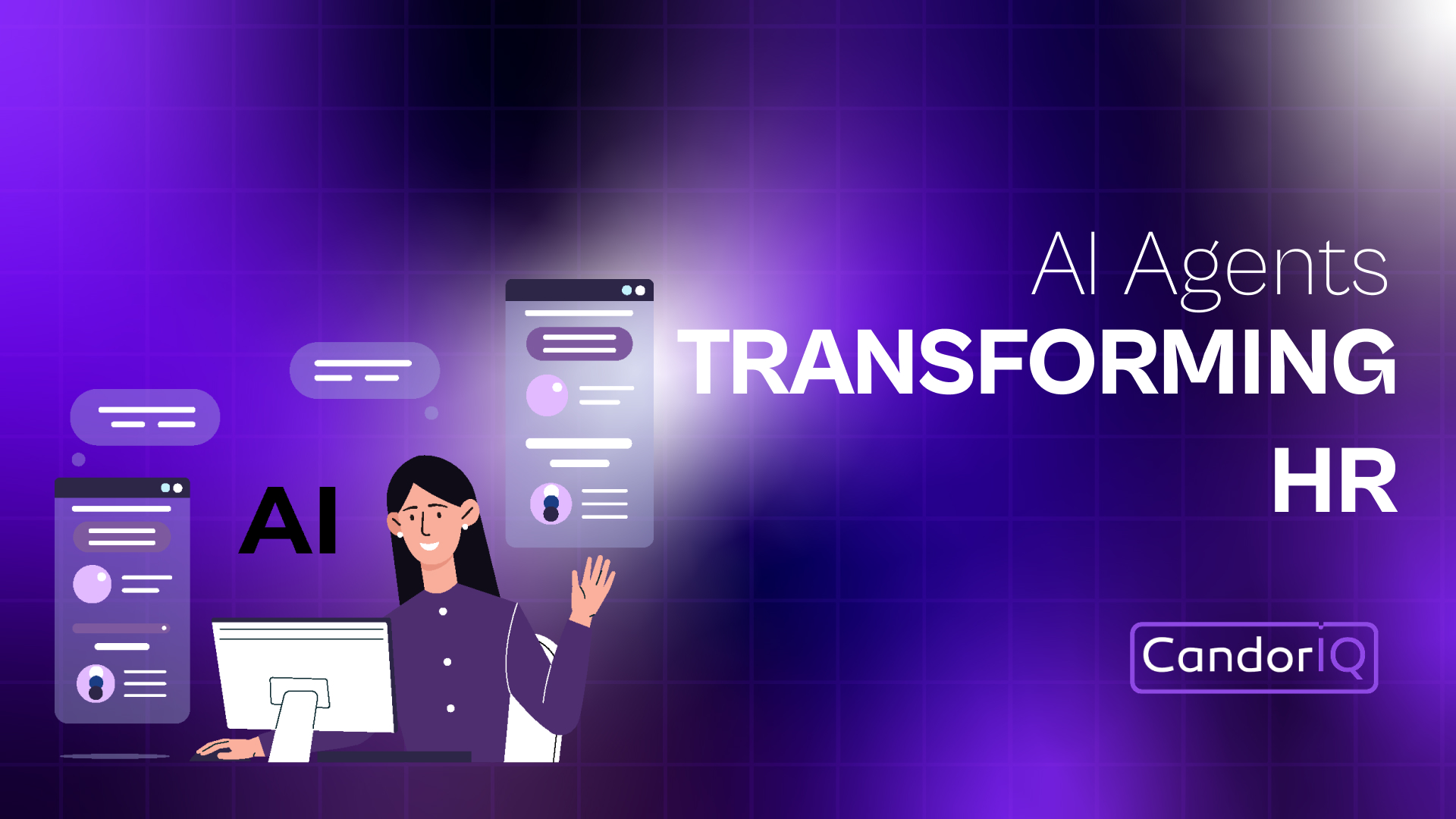
TL;DR
- AI agents automate repetitive HR tasks, enabling strategic focus and faster decisions.
- Key use cases include compensation equity monitoring, headcount forecasting, attrition risk prediction, and employee self-service.
- A well-designed HR tech stack with centralized data and API-first architecture maximizes AI effectiveness.
- Measuring impact through operational efficiency, retention, and budget accuracy ensures ROI.
- Platforms like CandorIQ integrate AI agents seamlessly, turning insights into actionable workforce strategies.
If you're still relying on manual processes and scattered tools, you're likely missing early warning signs of burnout, pay inequity, or attrition risk. As HR leaders, People Operations professionals, and HR Business Partners (HRBPs) face pressure to do more with less, AI agents offer a smarter, faster path forward. We understand that for mid-sized and fast-growing organizations typically with team sizes ranging from 50 to 5,000 employees, managing compensation and headcount planning with limited HR resources can feel overwhelming and stressful.
This blog explores how AI agents in HR streamline operations, reduce overhead, and drive better decisions, without increasing headcount. You’ll learn where they fit, how they work, and how platforms like CandorIQ make these capabilities immediately actionable.
What Is an AI in HR?
AI in HR refers to the application of intelligent technologies that help automate, predict, and personalize human resource functions, ranging from compensation planning and workforce forecasting to talent engagement and retention. But it's not about replacing people. It’s about enabling HR and Finance leaders, People Ops teams, and HR Business Partners to operate with greater speed, accuracy, and strategic foresight especially when managing a remote-first or globally distributed workforce.

Key Capabilities of AI in HR
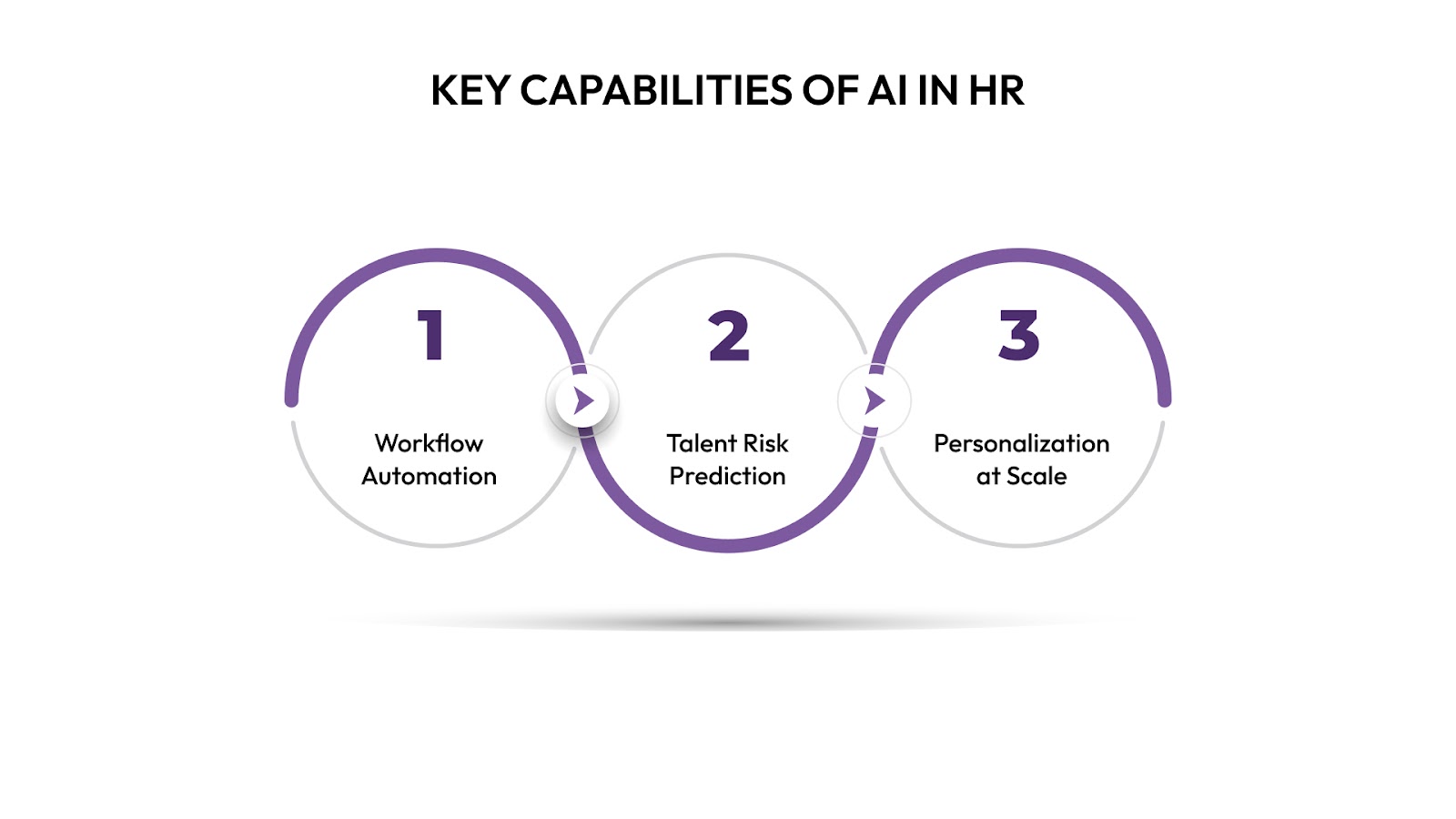
AI in HR is all about execution. These capabilities help transform HR from a reactive support function into a proactive, strategic driver of business outcomes.
1. Automation of Repetitive Workflows
AI streamlines manual tasks so your HR team can focus on strategy, not spreadsheets.
- Automatically route approvals for headcount or comp adjustments
- Pull data from multiple systems to build real-time dashboards
- Generate personalized candidate offers based on internal benchmarks
2. Predictive Intelligence for Talent Risk
AI doesn’t just track what’s happening, it forecasts what’s likely to happen next.
- Identify flight-risk employees using historical and behavioral data
- Model compensation gaps across job levels and locations
- Forecast the budget impact of hiring or attrition under different scenarios
3. Personalization at Scale
Every employee expects relevance, whether it’s in pay, feedback, or career pathing. AI helps tailor HR interventions at the individual level without adding administrative load.
- Surface customized growth plans based on performance and peer benchmarking
- Adjust compensation guidance based on skill rarity and role criticality
- Deliver real-time responses to common employee queries via AI agents
The work environment now is hybrid and has high-velocity and being reactive is a liability. If your HR systems can’t surface risk early or drive data-backed decisions, your business suffers, from higher attrition to misaligned budgets.
Platforms like CandorIQ use embedded AI to turn raw data into strategic action giving you visibility and control over your workforce, when and where it matters most.
Core Use Cases of AI Agents in HR

AI agents in HR are intelligent collaborators that not only automate simple tasks but also enhance management of compensation, workforce planning, and employee engagement. Whether you're scaling fast, doubling or even tripling headcount annually or trying to retain top talent, AI agents can help streamline decision-making, surface risks early, and reduce execution gaps across HR operations.
1. Compensation Intelligence and Equity Monitoring
AI agents can flag inconsistencies in pay bands, suggest location-based salary adjustments, and surface equity gaps across job families or regions, all in real time.
Key capabilities:
- Benchmark salaries against internal and external data
- Recommend compensation changes based on role performance and tenure
- Embed comp alerts during promotion or hiring approvals
2. Headcount Forecasting and Scenario Planning
Planning future headcount manually is time-consuming and prone to misalignment. AI agents help you model “what-if” scenarios and align hiring with budget and strategic priorities.
Use cases:
- Simulate team growth under different financial constraints
- Flag over-hiring risks and hiring delays
- Adjust forecasts based on churn, productivity data, and business pipeline
3. Attrition Risk Prediction
AI agents proactively flag employees showing signs of disengagement or flight risk, based on factors like compensation gaps, promotion delays, and sentiment indicators.
What this enables:
- Personalized retention strategies before problems escalate
- Early intervention during performance or comp cycles
- Prioritization of at-risk talent during workforce reviews
4. Offer Workflow & Candidate Communication
AI agents streamline the offer-to-hire journey by generating competitive offers, visualizing total compensation, and managing candidate FAQs, freeing up recruiter bandwidth.
Key benefits:
- Dynamic offer creation based on benchmarks and internal comp bands
- Total comp visualization (equity, bonus, benefits)
- Automated answers to candidate queries on process or perks
5. Employee Self-Service & Experience Enhancement
From leave policies to PTO balances, AI agents instantly respond to common employee questions, improving satisfaction while reducing HR ticket volume.
AI agents help:
- Deliver 24/7 support without increasing HR headcount
- Route complex requests to the right team with context
- Track and learn from recurring employee queries to improve documentation
AI agents in HR are enablers of faster decisions, better budget control, and more consistent employee experiences. By embedding them into platforms like CandorIQ, you connect workforce strategy with real-time execution, while freeing up your HR and Finance teams to focus on growth.
Designing an HR Tech Stack for AI Agents
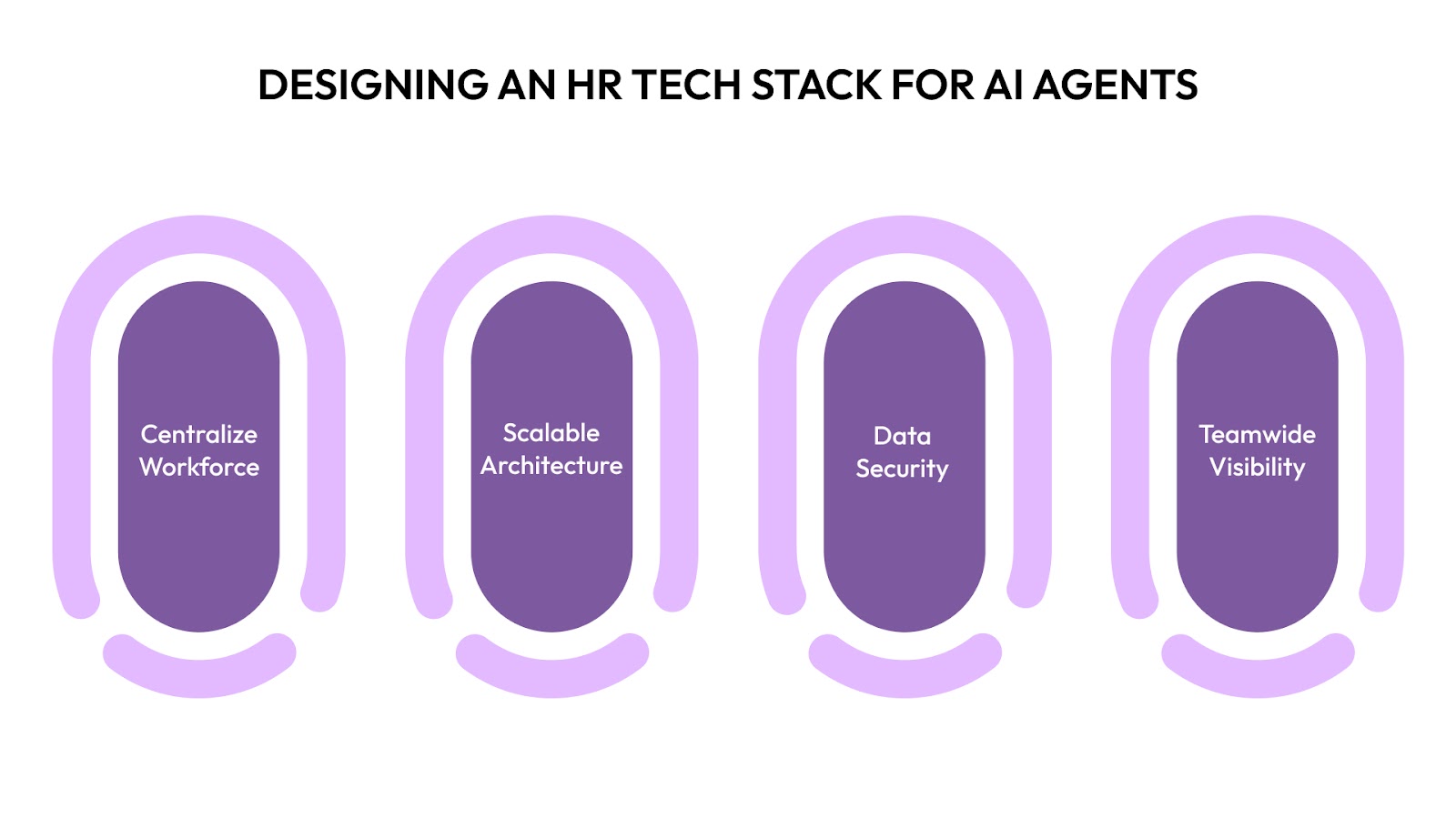
A well-integrated foundation ensures your AI agents can access the right data, deliver accurate recommendations, and automate decisions across the employee lifecycle. Without that alignment, even the most advanced AI remains underutilized.
1. Centralize Workforce Data Sources
AI agents thrive on context. That means pulling real-time, accurate inputs from multiple systems, without manual reconciliation or versioning delays.
Core integrations to prioritize:
- HRIS (e.g., Workday, BambooHR): Employee records, job levels, tenure
- ATS (e.g., Greenhouse, Lever): Hiring velocity, candidate stage data
- Payroll & Benefits Systems: Salary, equity, PTO, and total comp structure
- Performance Management Tools: Feedback cycles, promotion readiness
With CandorIQ, these integrations feed into a unified platform, giving AI agents a holistic view of headcount, compensation, and organizational health.
2. Prioritize API-First, Scalable Architecture
Many legacy HR systems lack interoperability. Choose tools that offer open APIs and allow data to flow securely between systems in real time.
Best practices:
- Select vendors with documented, bi-directional APIs
- Ensure role-based data access for privacy and compliance
- Leverage platforms like CandorIQ that natively sync with your HR and Finance stack
3. Embed Governance and Data Security
As AI agents handle sensitive HR information, compliance is foundational.
Your tech stack should support:
- Role-based access and audit trails
- Real-time change tracking for comp and headcount plans
- Secure data encryption in transit and at rest
4. Enable Cross-Functional Visibility
HR decisions don’t live in a vacuum. Your stack should support real-time visibility for Finance, HRBPs, and business leaders, so decisions are timely, aligned, and traceable. CandorIQ enables real-time collaboration across teams by allowing multiple stakeholders to view, comment, and take action on compensation plans, headcount forecasts, and risk alerts—simultaneously. This ensures decisions happen faster, with full context and alignment.
Look for platforms that offer:
- Custom dashboards by role and region
- Shared views for headcount, comp bands, and budget impact
- Embedded collaboration within workflows
Designing a tech stack for AI agents in HR create a tightly integrated system where insights and execution meet. With platforms like CandorIQ, you don’t just enable AI, you build a future-ready HR infrastructure that scales with your business.

Measuring the Impact of AI Agents
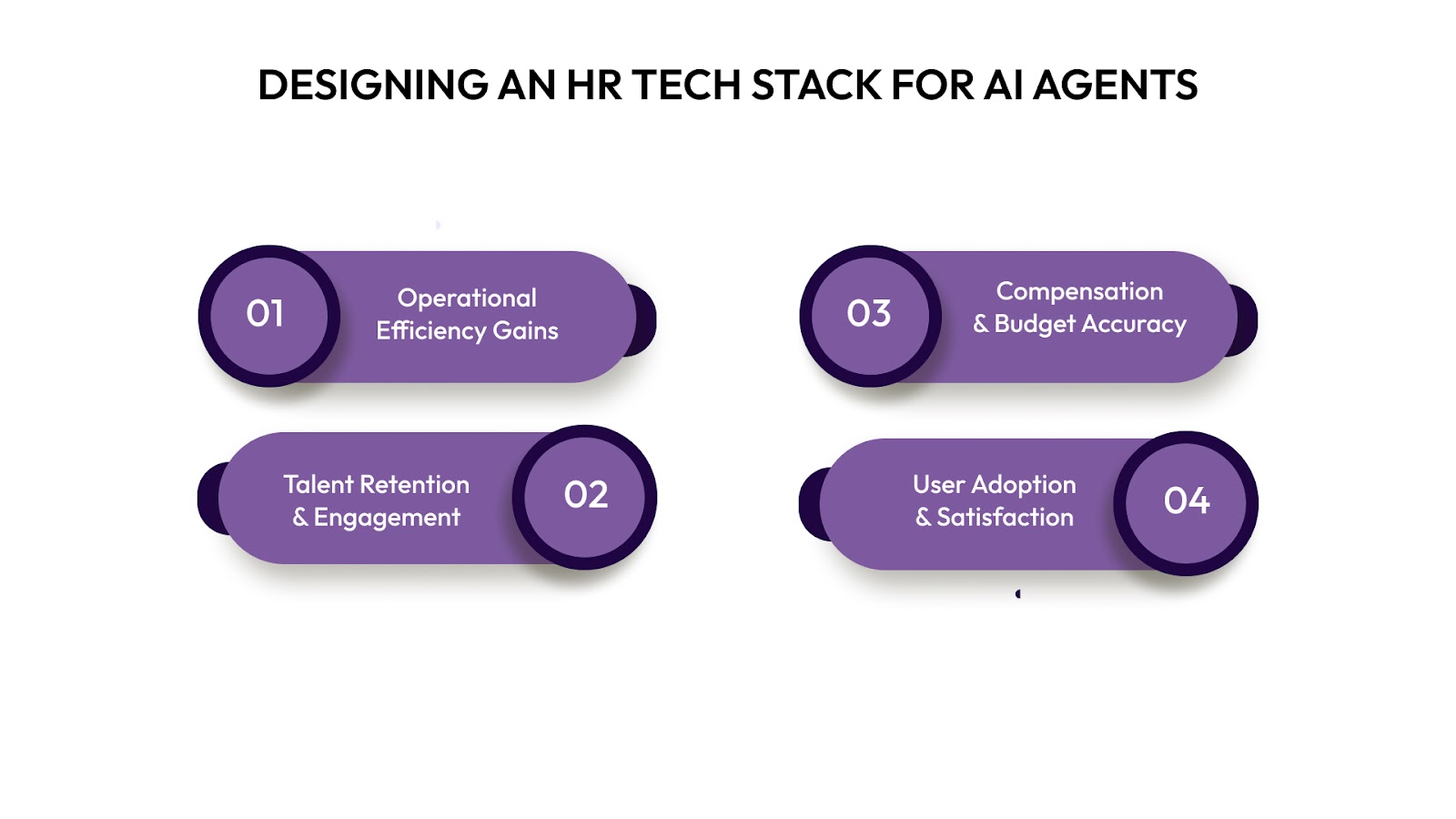
You can't optimize what you don't measure. As AI agents in HR move from pilot to enterprise scale, it’s critical to quantify their impact, not just on productivity, but on workforce planning, retention, and decision-making.
The right metrics help you justify investment, identify improvement areas, and align AI performance with business outcomes.
1. Operational Efficiency Gains
Evaluate how AI agents reduce manual work and accelerate workflows across HR and Finance.
Key KPIs:
- Time saved per compensation cycle or headcount planning round
- Reduction in manual errors or reconciliation steps
2. Talent Retention & Engagement
AI agents enable proactive action on attrition risks and pay equity, before they become costly.
Metrics to monitor:
- Regrettable attrition rate (pre- vs. post-AI implementation)
- Retention rate of high performers or high-cost roles
- Engagement scores in teams where AI is used for career pathing or workload balance
3. Compensation and Budget Accuracy
Track how AI-driven insights affect budget utilization, fairness, and planning precision.
Measurement points:
- Pay equity adjustments made proactively
- Alignment between forecasted and actual comp spend
- Over-/under-budget variance during merit cycles
4. User Adoption and Satisfaction
It’s not just about the tech, it’s about how your HR, Finance, and business teams use it.
Success indicators:
- System adoption rates by People Ops and Finance users
- User satisfaction with recommendations and workflow integrations
- Volume of actions triggered by AI signals (e.g., retention plans, comp changes)
AI agents are your strategic multipliers. But their value must be proven with the same rigor as any other business initiative. With CandorIQ, you get built-in tracking, tailored dashboards, and metrics that speak your language, from comp control to headcount efficiency.
Roadmap: Implementing AI Agents via CandorIQ
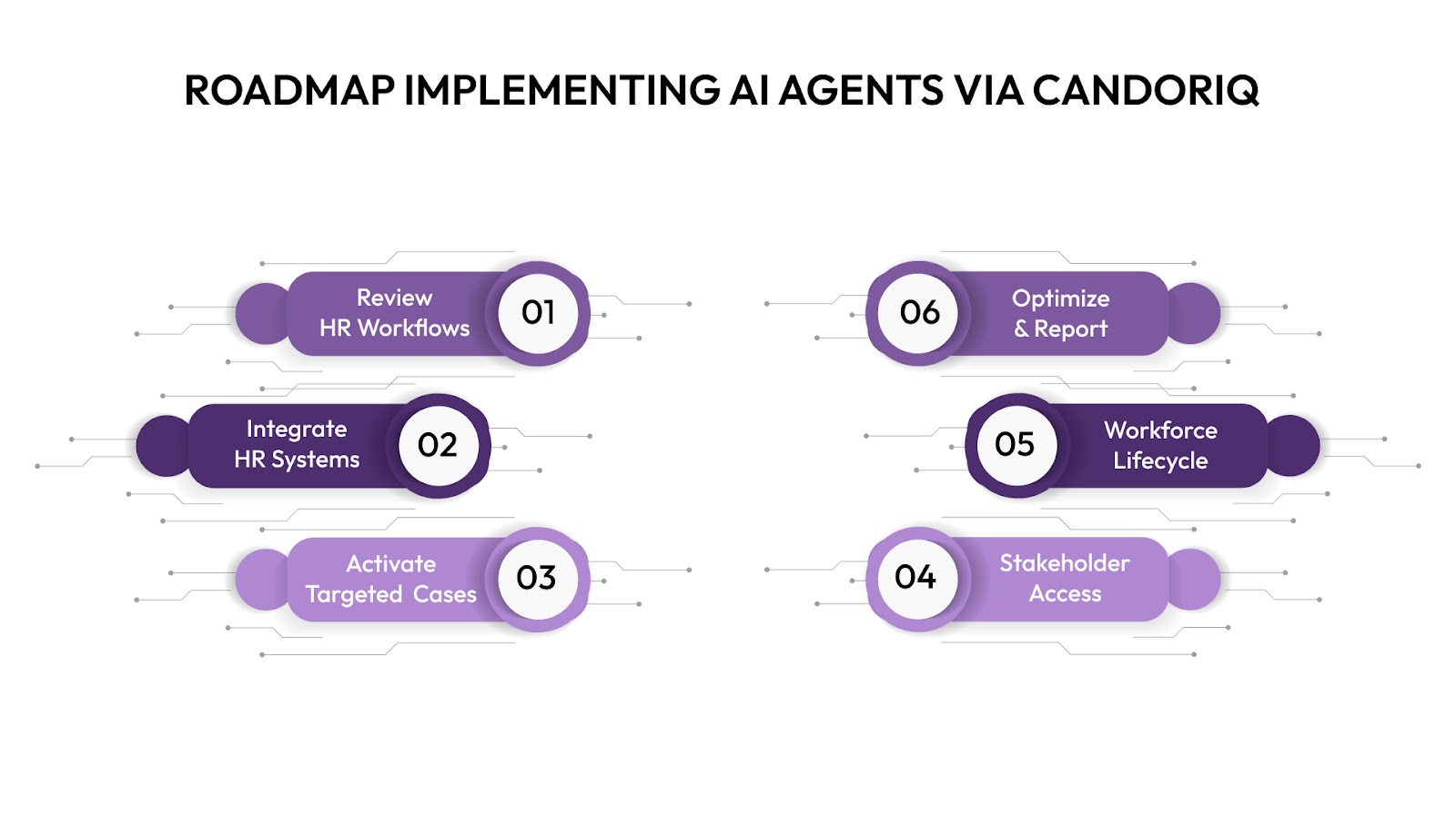
Introducing AI agents in HR is a strategic rollout that requires alignment across data systems, teams, and business goals. With CandorIQ, you gain a purpose-built platform designed to operationalize AI where it matters most: compensation, headcount planning, and employee retention.
Here’s how to do it right.
Step 1: Audit Current HR Workflows
Begin by identifying the manual processes and decision bottlenecks slowing down your HR and Finance teams.
Key areas to evaluate:
- Length of compensation planning cycles
- Accuracy of headcount forecasts
- Response time to approval requests or offer changes
- Visibility into workforce attrition risks
Step 2: Integrate Your Core HR Systems
AI agents perform best when connected to your existing tech stack. CandorIQ makes integration seamless across:
- HRIS (e.g., Workday, BambooHR)
- ATS (e.g., Greenhouse, Lever)
- Payroll and equity tools
- Performance and engagement platforms
This foundation enables unified views of comp history, hiring velocity, and employee lifecycle data.
Step 3: Activate Targeted Use Cases
Start with one high-impact domain, such as compensation cycle automation or flight-risk detection.
Examples:
- Deploy an AI agent to flag equity disparities across job levels
- Model hiring scenarios by location, budget, or skill demand
- Configure alerts for off-band comp offers or approval delays
Focus on measurable impact in the first 90 days to build internal momentum.
Step 4: Enable Stakeholder Access & Governance
Once your AI agent is active, ensure HRBPs, Finance, and leadership have tailored dashboards and secure access.
What to implement:
- Role-based access control
- Team-specific visualizations of comp, headcount, and risks
- Automated audit trails for transparency
Step 5: Scale Across the Workforce Lifecycle
With one use case delivering results, expand to other areas where AI can amplify decision-making.
Expansion opportunities:
- Automate new hire approval routing based on role, geography, or budget
- Deliver offer intelligence with real-time benchmarks
- Forecast attrition by role, tenure, or compensation gap
Step 6: Review, Refine, and Report
Establish quarterly reviews to track ROI and refine AI behavior based on organizational needs.
Track improvements in:
- Budget accuracy
- Time-to-decision for hiring and compensation
- Attrition among critical talent
CandorIQ’s reporting suite gives you clear visibility into performance.
AI agents in HR can’t succeed in isolation, they need structure, strategy, and seamless execution. With CandorIQ, you don’t just deploy AI; you turn it into a decision partner across HR and Finance.

Conclusion
The era of reactive HR is over. As your workforce grows more complex and your business faces tighter margins, AI agents in HR give you the edge, automating repetitive tasks, surfacing risks before they escalate, and aligning compensation with business priorities. But technology alone isn’t enough. You need a platform designed to turn insights into action.
CandorIQ integrates AI agents directly into your compensation and workforce planning workflows, so you’re not just collecting data, you’re making faster, smarter, and more equitable decisions.
Book a demo today and see how CandorIQ can transform your HR operations.


